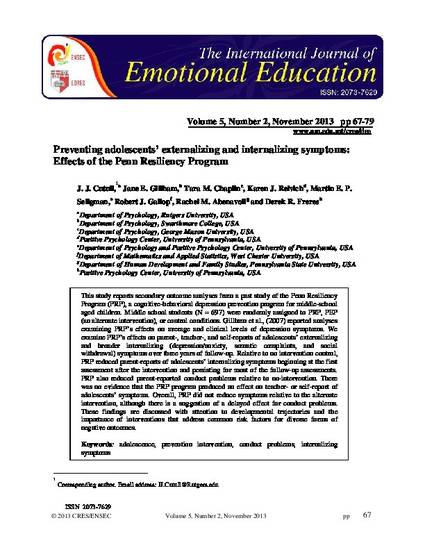
Article
Preventing adolescents’ externalizing and internalizing symptoms: Effects of the Penn Resiliency Program
International Journal of Emotional Education
(2013)
Abstract
This study reports secondary outcome analyses from a past study of the Penn Resiliency Program (PRP), a cognitive-behavioral depression prevention program for middle-school aged children. Middle school students (N = 697) were randomly assigned to PRP, PEP (an alternate intervention), or control conditions. Gillham et al., (2007) reported analyses examining PRP’s effects on average and clinical levels of depression symptoms. We examine PRP’s effects on parent-, teacher-, and self-reports of adolescents’ externalizing and broader internalizing (depression/anxiety, somatic complaints, and social withdrawal) symptoms over three years of follow-up. Relative to no intervention control, PRP reduced parent-reports of adolescents’ internalizing symptoms beginning at the first assessment after the intervention and persisting for most of the follow-up assessments. PRP also reduced parent-reported conduct problems relative to no-intervention. There was no evidence that the PRP program produced an effect on teacher- or self-report of adolescents’ symptoms. Overall, PRP did not reduce symptoms relative to the alternate intervention, although there is a suggestion of a delayed effect for conduct problems. These findings are discussed with attention to developmental trajectories and the importance of interventions that address common risk factors for diverse forms of negative outcomes.
Disciplines
Publication Date
November, 2013
Citation Information
J. J. Cutuli, Jane E. Gillham, Tara M. Chaplin, Karen J. Reivich, et al.. "Preventing adolescents’ externalizing and internalizing symptoms: Effects of the Penn Resiliency Program" International Journal of Emotional Education Vol. 5 Iss. 2 (2013) Available at: http://works.bepress.com/jj_cutuli/17/
